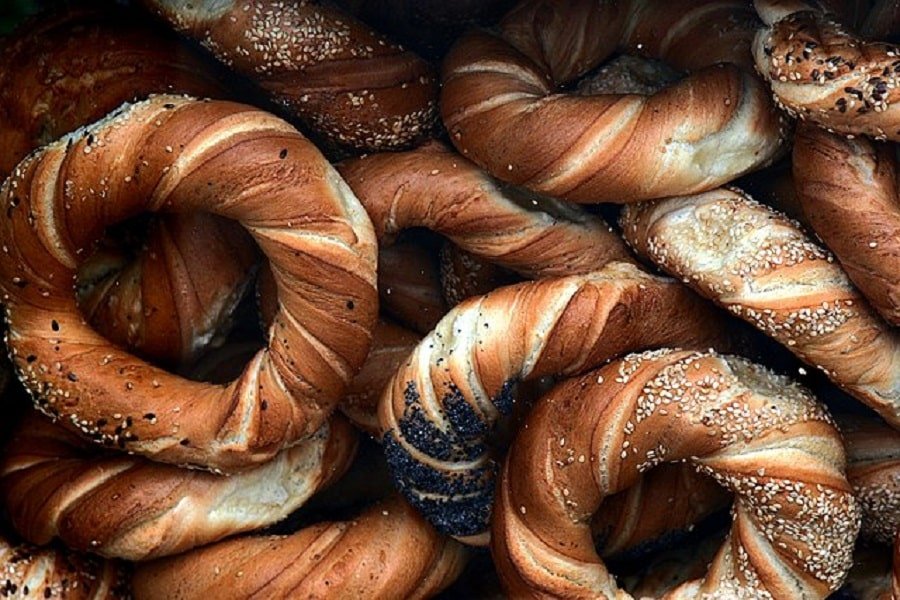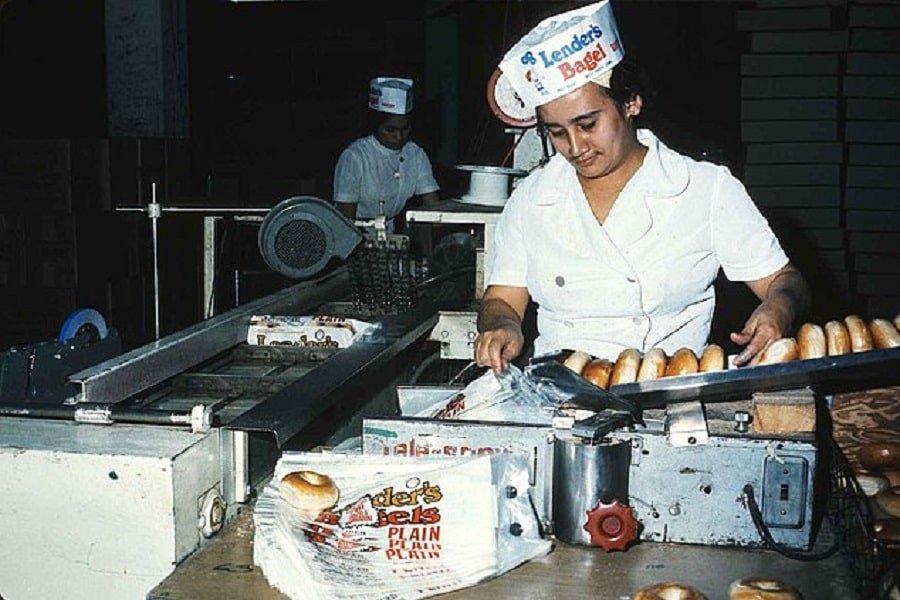Bagels – that extremely popular quintessentially American bread – actually has very humble origins, probably in Vienna. There are many stories about how bagels came to be invented but the most famous story was that a baker in Vienna crafted it in honor of the King of Poland, Jan Sobieski III. While a popular story, this seems unlikely. The Polish Jews have a long history of making bagels and the very method of making it – boiling the bread before baking – might be rooted in religious reasons.
Table of Contents
What Is the Origin of Bagels?

The safest assumption would be that bagels originated with Jewish bakers in Poland. While similar types of bread – such as German pretzels with holes in their center – had existed before, the particular method of creating a bagel is quite unique. The bagel dough itself is quite uncomplicated. It is the method of boiling and then baking that gives the bread its signature soft and chewy texture.
The first official mention of bagels comes from Poland in the early 1600s. Thus, we can assume that it had already been invented by that point. The story that a Viennese baker had come up with it as a tribute for King Jan Sobieski does not seem based in fact. Apparently, it was out of gratitude for the fact that the king had delivered Vienna from the Turkish invaders. The story goes that the baker knew of the king’s love for horses and made the bread in the shape of a stirrup. Thus, it was named ‘beugel’, which is the Austrian word for ‘stirrup’. King Jan loved it so much that it became a breakfast staple for him. It’s an entertaining little story. But bagels have been categorically mentioned in Polish texts long before King Jan took the throne or went to war against the Ottoman Empire.
Origins in Poland
In 1610, The Jewish Council of Krakow in Poland issued a regulation in Yiddish. It said that the local Jewish communities should not hold extremely elaborate celebrations for newborn babies so that the non-Jewish neighbors would not become too envious. Also, they did not wish for the members of the community to go bankrupt because of the celebrations. However, one food that they expected would be served was a bagel. This was the first official mention of bagels.
However, the root of the modern bagel can be traced as far back as the 1200s to a pretzel-like bread that was made in what is now Germany. In the Middle Ages, this would be served to monks in monasteries. It made its way to Poland in the 1300s. The Polish people modified the pretzel into small, round, single servings called obwarzanek. This means ‘boiled’ in Polish. The child queen Jadwiga of late 1300s Poland was said to be especially fond of the dish. Jadwiga allegedly opted for obwarzanek over the more traditional sweetbreads for Lent one year. And her people, eager to please her, attempted to buy the costly white flour in order to make it. The original bagel recipes evolved from the obwarzanek, which also had a hole in it.

Why Did Jewish Bakers Begin Making Bagels?
Bagels are a quintessentially Jewish food even today. But why did the Jewish bakers begin making this kind of bread? Well, in Medieval Europe, Church officials formally forbade Jews the right to bake bread. The Church viewed bread as a holy food and thought it was too good for the Jews. This was a view that was challenged in Poland, which was more liberal than the other European nations of the time.
The Polish Prince Boleslaw the Pious announced in 1264 that Jews had as much right as Christians to touch, buy, and sell bread. Thus, cautiously, the Polish Jews began to make a kind of bread. They still could not make the ordinary bread that was so sacred to Christians, since the Church warned their congregations against buying it. So they developed their own recipes for making boiled bread. They adapted the German pretzels but boiled them instead of baking them. Eventually, this came to be called the bagel.
Even today, traditionally, bagel dough is first boiled before being baked at high temperatures. This gives the bagel its typical shiny appearance and chewy texture. Originally, bagels were only enjoyed by the wealthier upper classes since the white flour made it quite costly. But over the years it has become a common street food in Poland, sold on sidewalks everywhere. No doubt Queen Jadwiga’s approval had a great role to play in making it universally popular.
How Did Bagels Come to New York?

As the Polish Jews began to emigrate to the United States in the 1900s, they brought their traditions of making bagels with them. Many of these people began their careers by selling bagels on a pushcart on the streets of New York City. At first, it was a niche delicacy that was enjoyed by the Jewish community alone. But by the 1950s, it had become extremely popular.
Curbside markets on Manhattan’s Lower East Side began to sell bagels in great numbers. They hung on strings and poles and made for convenient food even for those with limited budgets. Different cities with large Jewish communities began to claim that they made the best bagels in the world. Thus, there are New York bagels and Montreal bagels, and they have distinctive traits and qualities.
Now, the bagel has become one of the most common breakfast or brunch foods in North America.
What Were Bagels Originally Called?
It is unclear how the term ‘bagel’ first originated. There is of course the story of King Jan and the word ‘buegel’ which means ‘stirrup.’ This was supposed to refer to the distinctive shape of the bagel, with the hole in the center.
However, linguist Leo Rosten wrote that the ‘bajgiel’ was given to women in childbirth as a gift in the early 1600s. ‘Bajgiel’ is derived from the Yiddish word ‘beygal’ from the German dialect word ‘beugel’ which means ‘bracelet’ or ‘ring’. The ‘bajgiel’ became a staple in Poland in the 16th and 17th centuries.
The Yiddish ‘beygl’ or ‘beygal’ may have been rooted in the Middle High German ‘böugel’ or ‘ring’. This is also similar to the Old English ‘bēag’ meaning ‘ring’ and ‘būgan’meaning ‘to bend, bow’. Both of these could apply to the bagel, either referring to the shape or the method of shaping it.
In London, England, bagels (usually spelt ‘beigels’) have been commonly sold since the middle of the 19th century. This was especially true of districts like the Brick Lane districts which had sizable numbers of Ashkenazi Jews.
History of Bagels in America

The first bagels in America and New York City weren’t exactly the soft and sweet bagels that we are used to presently. They had a bit of a crunch and were smaller in size. These kosher bagels can still be found in certain places but are not as common.
It was in the 1970s that bagels became really popular because of a push for eating ‘ethnic’ foods. A man called Murray Lender, who grew up working in his family’s Jewish bakery in New Haven, Connecticut, was largely responsible for this push. Bagels were sold in much larger numbers on the weekends than on the weekdays. To deal with this disparity, in 1954 the Lenders began making bagels during the week and freezing them to sell on the weekends. Thus, frozen bagels emerged. And since defrosted bagels were harder than freshly made ones, the Lenders began to sell them pre-cut.
Evolution and Going Mainstream
In 1966, a bagel company became fully automated. Their first factory opened in the Bronx and replaced all the bakers who had previously hand-rolled, boiled and baked the bagel dough. Thus, with these new inventions, bagel bakeries mass-produced bagels.
Another innovation was the steaming rather than boiling of bagels. Since boiling and then baking took too much time, a little water was added to the commercial ovens. This helps produce a moister bread without taking too much time. This is the Chicago style of making bagels. They are usually machine-rolled and made in commercial steel ovens now.
In 1984, Kraft Foods (who own Philadelphia Cream Cheese) bought the company Lender’s Bagels. This resulted in the birth of the modern bagel industry. People began to eat bagels with cream cheese. Other flavorings added to bagels included everything from cheese to raisins and chocolate to blueberries. The sale of bagels began to even outstrip the sale of another bread with a hole in it – the doughnut.

READ MORE: Where Does Chocolate Come From? The History of Chocolate and Chocolate Bars
American companies began to have franchises worldwide. In Japan, for example, the first kosher bagels were brought by BagelK, a company from New York. BagelK created unique flavors for Japan, including green tea and banana-nut. Now, frozen bagels can be found in retail stores, such as Costco, all around the globe.
This modest bread made by Jewish Poles has gone through various changes. As toppings like cream cheese and lox have become more and more common, the holes have shrunk. Toppings of seeds, onion, garlic, and cheese have appeared. Rainbow-colored bagels made from colored dough are a new gimmick in American bakeries.
Variations

Even with the mass-produced bagels of modern times, there are many variations of the dish. This depends on the country or even the city that it is being produced in. Each place has put its own distinctive twist on the bagel and added its own signature flavors. One example of this would be the Jerusalem Bagel that sprung up in the Holy City in the 1960s. Jerusalem bagels are oval-shaped, softer, thinner, and sweeter and are usually served with their traditional spice blend, za’atar.
New York Style
New York bagels are the original kind of bagels found in the United States. This round bread still retains a great deal of the Jewish culture it was born out of. Locals believe the taste of the bread comes from the New York City tap water. It contains certain nutrients that make this a better kind of bread than bagels found elsewhere.
READ MORE: Who Invented Water? History of the Water Molecule
These bagels are boiled in water that has barley malt added. It is allowed to cold ferment for some time to enhance the flavors and the crust. These bagels are boiled in salted water before baking. Common seasonings added to these bagels are sesame seeds, poppy seeds, dried onion, garlic, or all of the above (everything bagel seasoning).
Austrian Style
Austrian bagels, called ‘beigl’, are traditionally enjoyed during Lent. Made from yeast dough, the rings are rolled out very thin and briefly boiled in salted water. They are topped with salt and caraway seeds before baking. They might be baked to a very hard consistency depending on the region. The Austrians have an Easter tradition where two people pull on the bagel from two ends until it breaks into two pieces. The person left with the larger piece is blessed with good luck.
Montreal Style

Montreal bagels are slightly different from New York ones. The dough contains malt and sugar but no salt. The bagels are boiled in water sweetened with honey before being baked in a wood-fired oven. Thus they are sweeter than the standard version and are usually only topped with white sesame seeds. Bagels in Toronto are not as sweet and are topped with poppy seeds before being baked in a standard oven.
St. Louis Style
The St. Louis style of bagels differs not in the method of preparation but in the style that it is cut. Most bagels are sliced once horizontally, which enables the preparation of sandwiches. St. Louis bagels, on the other hand, are sliced vertically multiple times. This was popularized by what is now the Panera Bread Company. They are generally sliced into eight neat slices with a bread slicer. This gives more surface area for spreads but it is not as convenient to carry as the standard bagel.
READ MORE: Who Invented the Sandwich and Where Did the Sandwich Come From?